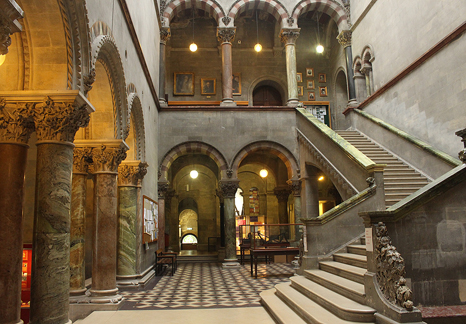The Museum Building of Trinity College: A Model of Victorian Craftsmanship
by Christine Casey and Patrick Wyse Jackson (Four Courts Press, €45)
Christopher Moriarty
Now is a fitting time to browse an extraordinary book about an extraordinary building.
Created in 1857, the Museum Building of Trinity College, Dublin has been a familiar object to generations of staff and students. Less well known to other Dubliners, it does form a backdrop to College Park, but most of the outsiders who congregate there are more interested in the sporting activities in progress than in architectural marvels.
Monument
Last autumn Christine Casey, Dublin’s foremost architectural historian, together with Patrick Wyse Jackson, a Professor of Geology who has worked in and loved the building for half a century, brought out a book about the museum, so well-written and beautiful that it provides an intellectual and pictorial monument of the same order of distinction as its subject.
Designed by two of Ireland’s greatest 19th-Century architects, Thomas Deane and Benjamin Woodward, it is a splendidly flamboyant conception.
This totally fascinating book will entertain and enlighten”
Inspired to some degree by palaces of Renaissance Italy, it is opulent and colourful making a dramatic contrast with the strictly classical buildings which defined 18th-Century Dublin.
If this book were simply a well-illustrated and scholarly description of the architecture, it would be a work of great interest. It does that part very well – but with a wealth of parallel chapters by various specialists describing aspects which seldom appear in architectural books.
The inspiration of Deane and Woodward in planning the building and its influence on many that would follow are obvious inclusions.
But the editors use the book as a vehicle to introduce studies of such related topics as the development of the marble quarrying industry in Ireland, and the story of the granite of west Wicklow which plays a great part in Dublin’s architecture.
There is extensive treatment of the ways and means of carving the innumerable decorations that grace the building and which in themselves present a galaxy of sculptures of birds, beasts and flowers.
This totally fascinating book will entertain and enlighten while we are confined to home and encourage the reader to go out and take a first, or at least a new look, at one of Dublin’s least known gems.


 The wonderful
interior of the
Museum Building
at Trinity College.
The wonderful
interior of the
Museum Building
at Trinity College. 